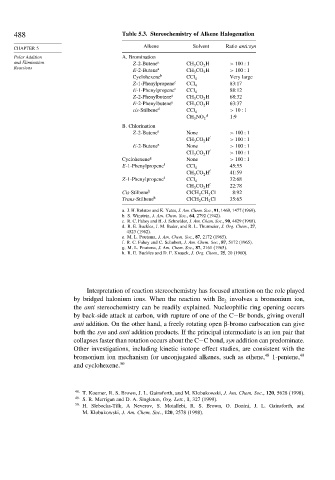Page 507 - Advanced Organic Chemistry Part A - Structure and Mechanisms, 5th ed (2007) - Carey _ Sundberg
P. 507
488 Table 5.3. Stereochemistry of Alkene Halogenation
Alkene Solvent Ratio anti:syn
CHAPTER 5
Polar Addition A. Bromination
and Elimination Z-2-Butene a CH 3 CO 2 H > 100 1
Reactions a
E-2-Butene CH 3 CO 2 H > 100 1
Cyclohexene b CCl 4 Very large
Z-1-Phenylpropene c CCl 4 83:17
E-1-Phenylpropene c CCl 4 88:12
Z-2-Phenylbutene a CH 3 CO 2 H 68:32
E-2-Phenylbutene a CH 3 CO 2 H 63:37
cis-Stilbene d CCl 4 > 10 1
d
CH 3 NO 2 1:9
B. Chlorination
Z-2-Butene e None > 100 1
CH 3 CO 2 H f > 100 1
E-2-Butene e None > 100 1
CH 3 CO 2 H f > 100 1
Cyclohexene g None > 100 1
E-1-Phenylpropene f CCl 4 45:55
CH 3 CO 2 H f 41:59
Z-1-Phenylpropene f CCl 4 32:68
CH 3 CO 2 H f 22:78
Cis-Stilbene h ClCH 2 CH 2 Cl 8:92
Trans-Stilbene h ClCH 2 CH 2 Cl 35:65
a. J. H. Rolston and K. Yates, J. Am. Chem. Soc., 91, 1469, 1477 (1969).
b. S. Winstein, J. Am. Chem. Soc., 64, 2792 (1942).
c. R. C. Fahey and H.-J. Schneider, J. Am. Chem. Soc., 90, 4429 (1968).
d. R. E. Buckles, J. M. Bader, and R. L. Thurmaier, J. Org. Chem., 27,
4523 (1962).
e. M. L. Poutsma, J. Am. Chem. Soc., 87, 2172 (1965).
f. R. C. Fahey and C. Schubert, J. Am. Chem. Soc., 87, 5172 (1965).
g. M. L. Poutsma, J. Am. Chem. Soc., 87, 2161 (1965).
h. R. E. Buckles and D. F. Knaack, J. Org. Chem., 25, 20 (1960).
Interpretation of reaction stereochemistry has focused attention on the role played
by bridged halonium ions. When the reaction with Br involves a bromonium ion,
2
the anti stereochemistry can be readily explained. Nucleophilic ring opening occurs
by back-side attack at carbon, with rupture of one of the C−Br bonds, giving overall
anti addition. On the other hand, a freely rotating open -bromo carbocation can give
both the syn and anti addition products. If the principal intermediate is an ion pair that
collapses faster than rotation occurs about the C−C bond, syn addition can predominate.
Other investigations, including kinetic isotope effect studies, are consistent with the
bromonium ion mechanism for unconjugated alkenes, such as ethene, 48 1-pentene, 49
and cyclohexene. 50
48
T. Koerner, R. S. Brown, J. L. Gainsforth, and M. Klobukowski, J. Am. Chem. Soc., 120, 5628 (1998).
49 S. R. Merrigan and D. A. Singleton, Org. Lett., 1, 327 (1999).
50
H. Slebocka-Tilk, A Neverov, S. Motallebi, R. S. Brown, O. Donini, J. L. Gainsforth, and
M. Klobukowski, J. Am. Chem. Soc., 120, 2578 (1998).

